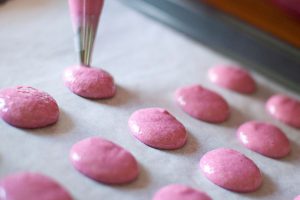
Image by: Elena Kovyrzina
There is a dessert that has taken the pastry world by storm in the last couple years and has been widely appreciated in America, resulting in a widely expanding population of pastry shops in the United States. I am talking about the art of the macaron which is one of the most difficult pastries to make and constantly confused for another dessert which is the macaroon.
Macaroons can still consist of ground almonds and are still considered meringues but usually are filled with coconut. Macaroons and macarons are similar but not synonymous as macaroons avoid certain stages that allow macarons to have the distinct delicate texture that most everyone enjoys. Still, there are two versions of macarons as macarons are meringue based; the versions vary based on the regional meringue recipe being used. A macaron can either be made by way of the Italian meringue and the French meringue; both create a different texture of macaron as the French meringue has more fat incorporated into it. Macarons are extremely difficult to make as they cake easily crack or deflate if the directions are not followed exactly as the recipe suggests.
When the macarons are piped, they are usually piped onto a silicone mat such as a silpat which will avoid the meringue from sticking during the drying and baking stage. After the macarons are piped, they are set to dry out to form a crust before they are baked accordingly. Macarons are typically piped into a circular shape but can be an array of other shapes as well like hearts or squares but those are more complex to pipe precisely.

Image by: Macquillage of Curiosity
The fillings typically used to sandwich between the two halves of a macaron are buttercream, caramel, ganache, as well as fruit fillings such as curd, jelly, and jam. The process of filling the macarons must be completed in a delicate manner as the meringues can easily crack. Usually, the fillings are piped onto the meringue half rather than being spooned onto it.
Basic Macaron Recipe

Image by: Erika Low
Ingredients:
2/3 cup sliced blanched almonds
1 cup confectioners’ sugar
2 large egg whites, room temperature
1/4 cup granulated sugar
Jam or other filling
Directions:
Preheat oven to 350 degrees with rack in lower third. Place almonds in a food processor; process until as fine as possible, about 1 minute. Add confectioners’ sugar; process until combined, about 1 minute.
Pass almond mixture through a fine-mesh sieve. Transfer solids in sieve to food processor; grind and sift again, pressing down on clumps. Repeat until less than 2 tablespoons of solids remains in sieve.
Whisk egg whites and granulated sugar by hand to combine. Beat on medium speed (4 on a KitchenAid) 2 minutes. Increase speed to medium-high (6) and beat 2 minutes. Then beat on high (8) 2 minutes more.
The beaten egg whites will hold stiff, glossy peaks when you lift the whisk out of the bowl. Add flavoring and food coloring, if desired, and beat on highest speed 30 seconds.
Add dry ingredients all at once. Fold with a spatula from bottom of bowl upward, then press flat side of spatula firmly through middle of mixture. Repeat just until batter flows like lava, 35 to 40 complete strokes.
Rest a pastry bag fitted with a 3/8-inch round tip (Ateco #804) inside a glass. Transfer batter to bag; secure top. Dab some batter remaining in bowl onto corners of 2 heavy baking sheets; line with parchment.
With piping tip 1/2 inch above sheet, pipe batter into a 3/4-inch round, then swirl tip off to one side. Repeat, spacing rounds 1 inch apart. Tap sheets firmly against counter 2 or 3 times to release air bubbles.
Bake 1 sheet at a time, rotating halfway through, until risen and just set, 13 minutes. Let cool. Pipe or spread filling on flat sides of half of cookies; top with remaining half. Wrap in plastic and refrigerate.
Adapted from Martha Stewart



